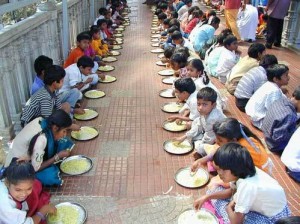In 2001, as part of the Indian government’s commitment to the Right to Food, the Supreme Court implemented the Mid-Day Meal Scheme, requiring state governments to provide lunch in government and government-assisted primary schools.

One in every three malnourished children in the world lives in India, and an estimated 13.5 million children do not attend school. Instead, many of these children spend their day rummaging through piles of garbage for metal scraps that they can sell to buy a single meal. Ask these children why they don’t go to school and they will say: if we go to school, we won’t have time to earn money to buy food.
The Akshaya Patra Foundation, an NGO which supports the world’s largest school feeding program, is taking the lead as the implementing arm of the Indian government. By providing nutritious meals to students, Akshaya Patra, which means “inexhaustible vessel” in Sanskrit, strives to ensure that “no child in India shall be deprived of education because of hunger.”
School feeding programs are designed to help address the link between hunger and education – they improve nutrition by providing children with their first and perhaps, only meal of the day, and create an incentive for parents to enroll their children in school.
In 2003, Akshaya Patra partnered with the Karnataka state government to implement a mid-day meal program in response to the Supreme Court order. Today, the NGO works in seven Indian states including Gujarat, Rajasthan and Uttar Pradesh. 50 percent of its expenses are covered by state governments, while corporations and individual donors account for the rest.
The implementation of country-wide programs, like the Mid-Day Meal Scheme, can prove extremely challenging for governments. But the Karnataka state government’s decision to involve NGOs, such as Akshaya Patra, has helped encourage important private-public partnerships.
Today, the Bangalore-based NGO provides meals to more than 1.2 million children in over 6500 school across seven Indian states. In September 2008, the NGO received a letter from Barack Obama, praising its efforts as “an imaginative approach that has the potential to serve as a model for other countries.”
The program’s success is due in part to its ability to adapt to local realities and customs. In densely populated areas, the program uses specialized kitchens to support large-scale production in a short period of time. In rural areas, however, they use the de-centralized kitchen model, where women’s self-help groups cook and distribute meals to village schools.
Akshaya Patra sets its goals high; the NGO aims to reach 5 million children by 2020. But in a country where 75 percent of the poor are located in rural areas, the success of school feeding programs will depend on their ability to access village communities. Further, Akshaya Patra must strengthen its model by procuring food locally and creating more jobs in local communities.
As India continues on a path of fast-paced economic growth, these innovative private-public partnerships may be the key to ensuring that its children have access to education and nutritious food.

Danielle Nierenberg, an expert on livestock and sustainability, currently serves as Project Director of State of World 2011 for the Worldwatch Institute, a Washington, DC-based environmental think tank. Her knowledge of factory farming and its global spread and sustainable agriculture has been cited widely in the New York Times Magazine, the International Herald Tribune, the Washington Post, and
other publications.
Danielle worked for two years as a Peace Corps volunteer in the Dominican Republic. She is currently traveling across Africa looking at innovations that are working to alleviate hunger and poverty and blogging everyday at Worldwatch Institute’s Nourishing the Planet. She has a regular column with the Mail & Guardian, the Kansas City Star, and the Huffington Post and her writing was been featured in newspapers across Africa including the Cape Town Argus, the Zambia Daily Mail, Coast Week (Kenya), and other African publications. She holds an M.S. in agriculture, food, and environment from Tufts University and a B.A. in environmental policy from Monmouth College.










